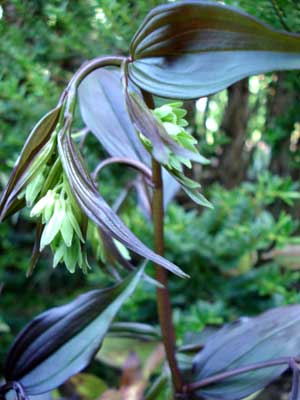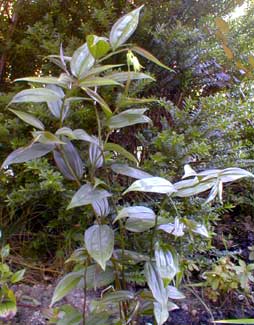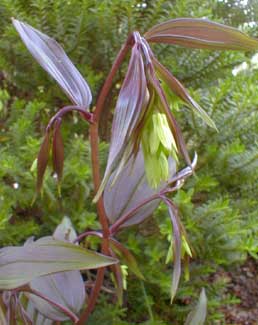
'Night Heron'
Cantonese Fairybells
"O happy Garden! whose seclusion deep
Hath been so friendly to industrious hours;
And to soft slumbers, that did gently steep
Our spirits, carrying with them dreams of flowers."
-William Wordsworth
(1770-1850)
(1770-1850)
 Some varieties of Disporum cantoniense are described as having "a bambooish air," & 'Night Heron' is one such.
Some varieties of Disporum cantoniense are described as having "a bambooish air," & 'Night Heron' is one such.Of the two starts we obtained some years back, one was "plain" DJHC 739 having dark green leaves with mahogany highlights, the other was 'Night Heron' the leaves of which emerge blackish purple in April.
Both 'DJHC 739' & 'Black Heron' are growing together in a shade-garden, maturing into a single patch, with 'Night Heron' on the left starting out slightly slower in its growth rate, though soon both became tall twins of light & dark. The plain green, alongside the dark-leafed 'Night Heron,' provide very much a distinctive contrast to one another.
 Besides a play off the name of Heronswood Nursery (where the black strain was preserved & developed under the original ownership), the name 'Night Heron' alludes to the Black-crowned night-heron (Nycticorax nycticorax), a bird with a four-continent distributioin & which is as dark, upright, & stately as the 'Night Heron' Fairybells.
Besides a play off the name of Heronswood Nursery (where the black strain was preserved & developed under the original ownership), the name 'Night Heron' alludes to the Black-crowned night-heron (Nycticorax nycticorax), a bird with a four-continent distributioin & which is as dark, upright, & stately as the 'Night Heron' Fairybells.And indeed, the plant as it emerges in spring stands tall with a bowed head, looking an awful lot like the stance of a black heron.
In April, when the upright stems are still new & fresh & chocolately-black, dangling pale yellow flowers appear at leaf axels, & is in fullest bloom for most of May. It produces more flowers well into summer, but they are not as showy when the foliage has increased later in the year. The flowers are followed by purple-black berries which add another level of ornamental interest.
The root becomes a slender divided tuber like a split carrot. It sends underground rhizomes throughout the vicinity to colonize an area, but is not aggressive toward other plants.
It wants rich humusy evenly moist soil in light shade. It can be grown down to USDA zone 5, but will have winter die-back. In our mild Puget Sound winters, it remains nearly evergreen. In a protected spot the leaves can still look great through most of the winter. It is recommended to cut them back just before spring to make room for new growth.
Disporum flavum, Korean Fairybells